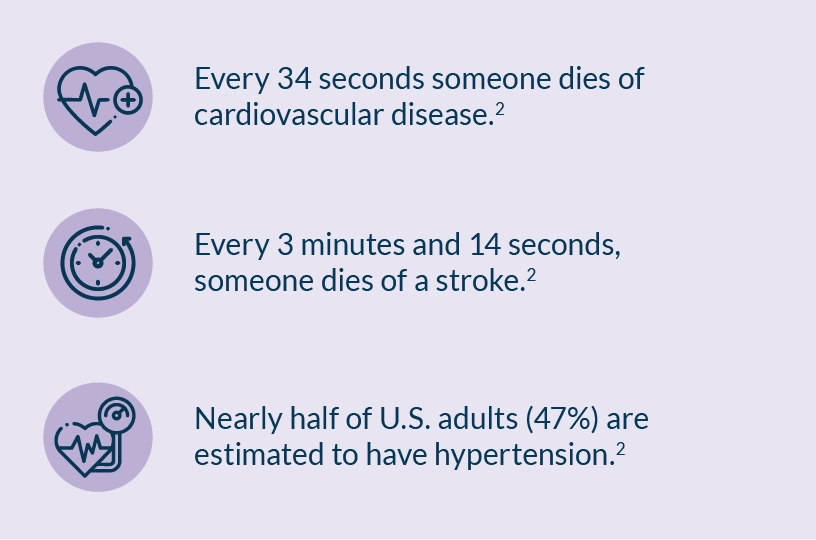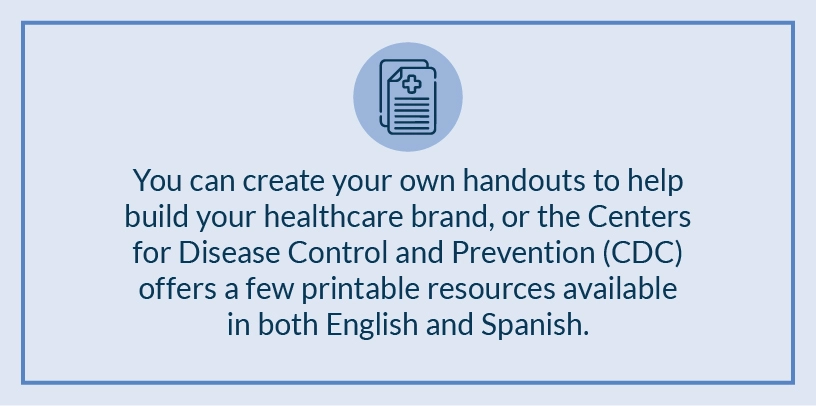Healthcare Leaders: How Do You Promote Heart Health Awareness?

Empower Your Employees to Advocate for Cardiovascular Wellness
Heart disease has been the leading cause of death in the U.S. since 1921 — more than 100 years — but one survey found that more than half of U.S. adults weren’t aware that it is the number one threat to their life and health.1 Healthcare organizations can help change this, and what better time to start than Heart Health Awareness Month. This February, healthcare industry leaders can take part in this initiative by sharing information about cardiovascular disease (CVD), providing heart-healthy tips, and encouraging the development of a healthy diet and exercise routine. Another way to further this effort is to empower your healthcare team to promote cardiovascular wellness in patients, which is critical since this issue affects so many individuals and their families.
Heart Disease by the Numbers

Heart disease claims 702,880 lives annually.3 This is roughly the same number of people living in Washington D.C.4 Imagine visiting our nation’s capital today to see it brimming with people, only to return a year later and find a ghost town — all because of heart disease-related deaths.
This represents the magnitude of the issue we currently face. It also reinforces why heart health awareness is such a worthwhile cause, especially for certain populations.
Heart Health Disparities
While heart disease can affect anyone, research has found that some communities have an elevated risk of CVD-related death. As an example, a 2024 study looked at CVD deaths in California between 1999 and 2021 and reported that mortality rates were disproportionately higher for Black, American Indian, Pacific Islander, and Asian males, as well as being higher for populations with lower socioeconomic statuses.5
Sexual identity may also play a part in cardiovascular health. A study involving 12,180 adult Americans found that non-heterosexual Black, Hispanic, and White females had lower cardiovascular health scores than their heterosexual counterparts.6 Authors attributed this, in part, to discrimination in healthcare.
Heart Disease Risk Factors
Several factors can affect a person’s heart disease risk. Some are unchangeable (like age, sex, race/ethnicity, and family history), while others can be modified to potentially reduce the risk (including those related to diet, exercise, alcohol intake, smoking, stress, and sleep habits).7
Healthcare staff can play a positive role in both — whether through patient education or providing guidance on lifestyle changes — making them important players in the fight to promote heart health.
Equipping Healthcare Employees to Combat Cardiovascular Disease
Prioritizing heart health awareness within your organization is a good first step toward furthering this initiative. To raise awareness internally:
- Talk about heart health at staff meetings and share CVD statistics in your employee newsletters. Bring in a cardiac health expert for an in-house training session.
- Allow team members to wear red on the first Friday in February, known as National Wear Red Day. Encourage them to post a picture on social media with a branded hashtag.
- Create a team to participate in the American Heart Association’s Heart Walk. For example, 130 Ultimate Medical Academy (UMA) team members walked in person and still more walked virtually, raising almost $35,000 for the AHA.
Note: Nasium Training is UMA Education, Inc.’s workforce development arm offering short, unaccredited, and customized healthcare training opportunities to its employer partners.
To pass this same information on to patients, create heart health handouts or fact sheets that front desk staff can give to patients when they check in or out. Set these sheets in various locations throughout your office or facility where patients or customers can pick them up freely. Place them on end tables in your waiting rooms or exam rooms, for example. Pharmacies and healthcare product suppliers might place a brochure rack on the checkout counter.

Giving frontline employees access to resources that promote heart health awareness enables them to pass this information on to the people you serve. If your healthcare facility specializes in cardiac care, you can go one step further by providing employees in medical assistant roles with the foundational education needed to work with patients who have cardiovascular health issues.
Medical Assistant Training with a Cardiac Component
Medical assistant training typically includes important topic areas such as infection control, how to collect and record vital signs, lab collection and testing, and basic pharmacology. Nasium Training’s Medical Assistant training series also covers cardiac procedures, providing learners with skills that can benefit them when working in a cardiac care facility.
In an April 2024 news release, the American Heart Association stresses that healthcare professionals should offer patients with heart disease “clear, jargon-free and relevant information” about heart disease risk factors and screening and treatment options.8 Medical assistant training that includes cardiac procedures can give these professionals the education needed to relay this information accurately (staying within their scope of practice, of course).
Medical assistants can be a valuable part of the cardiac care team. They can help collect and record patient health information, assist in minor surgical procedures, encourage patients to attend follow-up appointments, and serve as a liaison between the patient and other healthcare staff. Training that includes a cardiac component can help prepare them for this critical role.
Empower Your Staff with Medical Assistant Training
Healthcare organizations can empower their staff to promote heart health awareness in several ways. One is to give them printed information they can disseminate to patients. Another is to provide them with medical assistant training that also covers cardiac procedures, such as the program offered by Nasium Training.
Our 25-week medical assistant training series offers online instruction combined with in-person training to advance learners’ clinical skills. It helps your employees develop both the back and front office skills that enable them to enhance your office’s efficiency while providing high-quality patient care. This training series also prepares learners to sit for the Certified Clinical Medical Assistant (CCMA) certification exam offered by the National Healthcareer Association, and even includes the exam fee.
If you have any questions or would like to discuss how our Medical Assistant training can help you upskill, reskill, or cross-skill your healthcare employees, contact us today. We have a true passion for heart health and would love to help further awareness of this topic in any way we can!
1 AHA. More than half of U.S. adults don’t know heart disease is leading cause of death, despite 100-year reign. https://newsroom.heart.org/news/more-than-half-of-u-s-adults-dont-know-heart-disease-is-leading-cause-of-death-despite-100-year-reign
2 American Heart Association. Heart Disease & Stroke Statistics 2024 Update. https://www.heart.org/-/media/PHD-Files-2/Science-News/2/2024-Heart-and-Stroke-Stat-Update/2024-Heart-and-Stroke-Statistics-Infographics.pdf
3 Centers for Disease Control and Prevention. National Center for Health Statistics. Leading Causes of Death. https://www.cdc.gov/nchs/fastats/leading-causes-of-death.htm
4 Government of the District of Columbia. New Census Data Shows DC’s Population Surpasses 700,000 for the First Time in Five Years. https://mayor.dc.gov/release/new-census-data-shows-dc%E2%80%99s-population-surpasses-700000-first-time-five-years
5 Bhatta D, Bommer W. Trends in California Cardiovascular Disease Mortality: Sex-Race/Ethnicity Disparity and Income Inequality. Mayo Clinic Proceedings. https://www.sciencedirect.com/science/article/abs/pii/S0025619624001046
6 Rosendale N, et al. Differences in Cardiovascular Health at the Intersection of Race, Ethnicity, and Sexual Identity. JAMA Netw Open. https://jamanetwork.com/journals/jamanetworkopen/fullarticle/2818121
7 National Library of Medicine. How to Prevent Heart Disease. https://medlineplus.gov/howtopreventheartdisease.html
8 AHA. Cardiovascular care centered on the patient is key and helps improve equity and outcomes. https://newsroom.heart.org/news/cardiovascular-care-centered-on-the-patient-is-key-and-helps-improve-equity-and-outcomes
